Report on People Management and Development Strategies for Performance
VerifiedAdded on 2023/01/13
|21
|5660
|98
Report
AI Summary
This report delves into the crucial aspects of people management and development strategies, exploring the alignment of people practices with organizational strategy and culture. It examines the objectives of human resource management (HRM), emphasizing its role in fostering a stable work environment, motivating employees, and improving organizational performance through practices such as teamwork and training. The report further analyzes the advantages of aligning people management policies with organizational strategy and risk, highlighting the importance of HR in securing the right talent and fostering a dynamic culture. It also evaluates how organizations integrate people management practices within their culture, brand, and values, and critically assesses models of systemic thinking, including the Cultural Web, and the role of people analytics. The report then examines different models of people practice management, such as the Standard Causal Model of HRM, and evaluates research linking people management with improved employer outcomes, as well as best practice, contingency, and resource-based approaches to the development of people practices, including labor market segmentation.
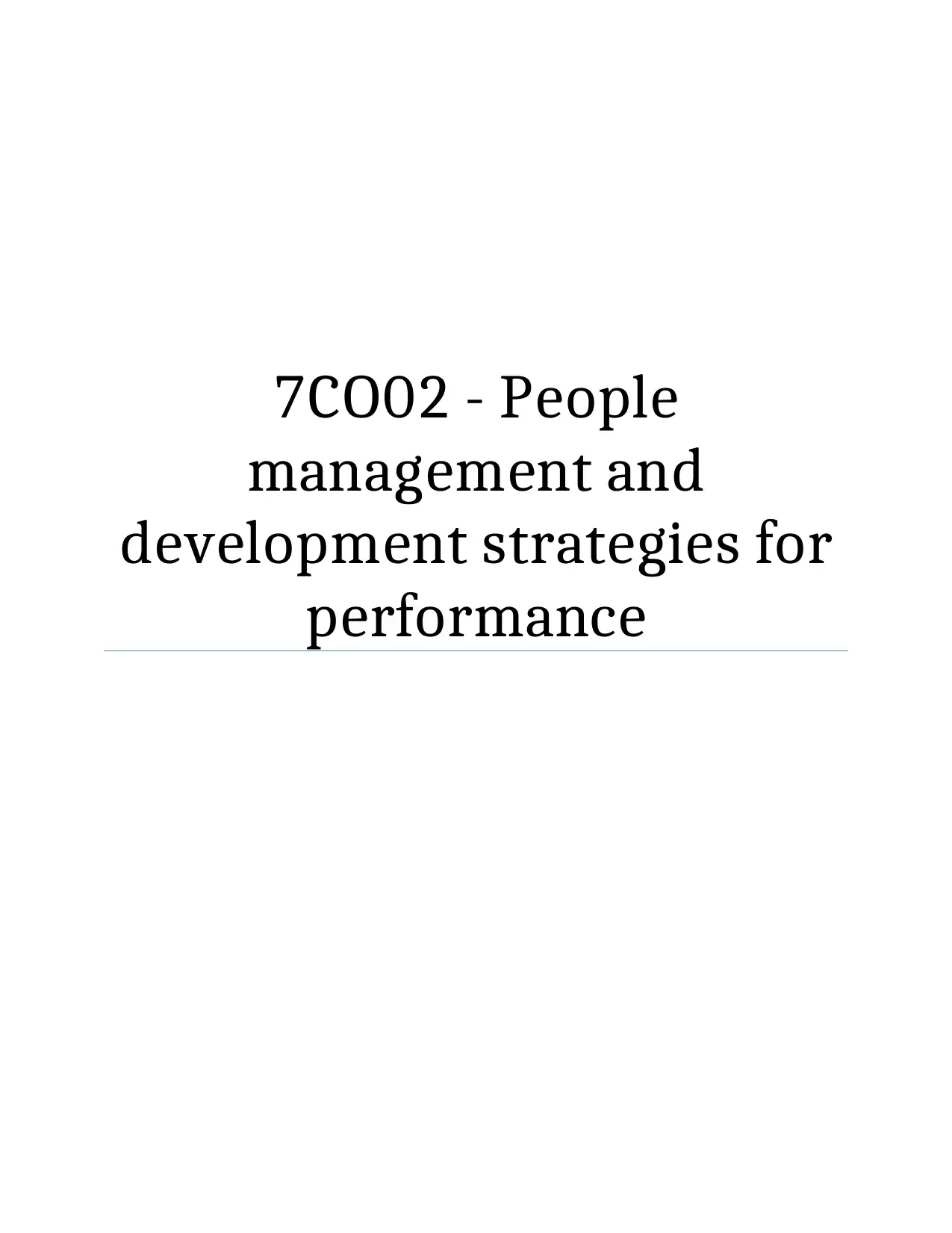
7CO02 - People
management and
development strategies for
performance
management and
development strategies for
performance
Paraphrase This Document
Need a fresh take? Get an instant paraphrase of this document with our AI Paraphraser
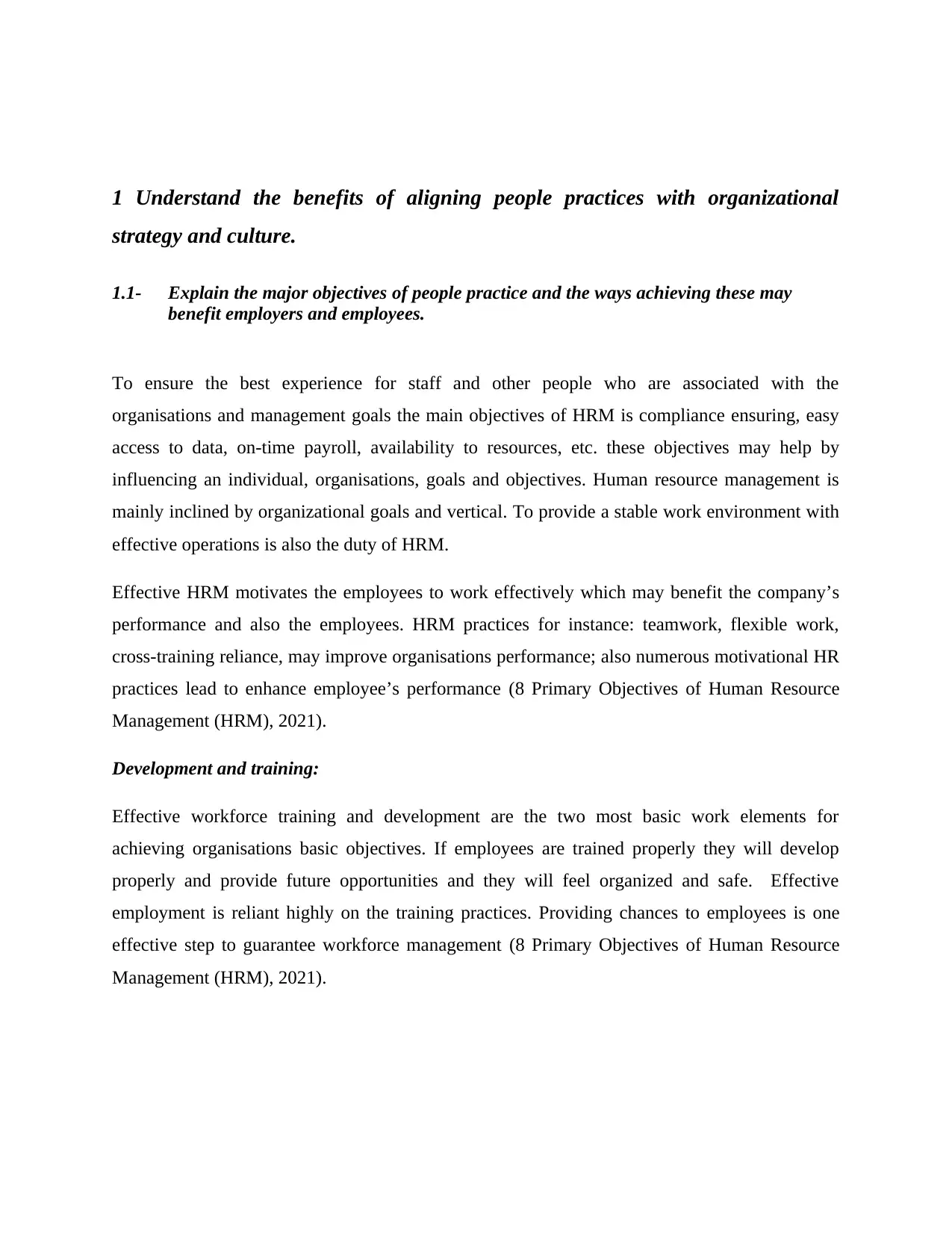
1 Understand the benefits of aligning people practices with organizational
strategy and culture.
1.1- Explain the major objectives of people practice and the ways achieving these may
benefit employers and employees.
To ensure the best experience for staff and other people who are associated with the
organisations and management goals the main objectives of HRM is compliance ensuring, easy
access to data, on-time payroll, availability to resources, etc. these objectives may help by
influencing an individual, organisations, goals and objectives. Human resource management is
mainly inclined by organizational goals and vertical. To provide a stable work environment with
effective operations is also the duty of HRM.
Effective HRM motivates the employees to work effectively which may benefit the company’s
performance and also the employees. HRM practices for instance: teamwork, flexible work,
cross-training reliance, may improve organisations performance; also numerous motivational HR
practices lead to enhance employee’s performance (8 Primary Objectives of Human Resource
Management (HRM), 2021).
Development and training:
Effective workforce training and development are the two most basic work elements for
achieving organisations basic objectives. If employees are trained properly they will develop
properly and provide future opportunities and they will feel organized and safe. Effective
employment is reliant highly on the training practices. Providing chances to employees is one
effective step to guarantee workforce management (8 Primary Objectives of Human Resource
Management (HRM), 2021).
strategy and culture.
1.1- Explain the major objectives of people practice and the ways achieving these may
benefit employers and employees.
To ensure the best experience for staff and other people who are associated with the
organisations and management goals the main objectives of HRM is compliance ensuring, easy
access to data, on-time payroll, availability to resources, etc. these objectives may help by
influencing an individual, organisations, goals and objectives. Human resource management is
mainly inclined by organizational goals and vertical. To provide a stable work environment with
effective operations is also the duty of HRM.
Effective HRM motivates the employees to work effectively which may benefit the company’s
performance and also the employees. HRM practices for instance: teamwork, flexible work,
cross-training reliance, may improve organisations performance; also numerous motivational HR
practices lead to enhance employee’s performance (8 Primary Objectives of Human Resource
Management (HRM), 2021).
Development and training:
Effective workforce training and development are the two most basic work elements for
achieving organisations basic objectives. If employees are trained properly they will develop
properly and provide future opportunities and they will feel organized and safe. Effective
employment is reliant highly on the training practices. Providing chances to employees is one
effective step to guarantee workforce management (8 Primary Objectives of Human Resource
Management (HRM), 2021).
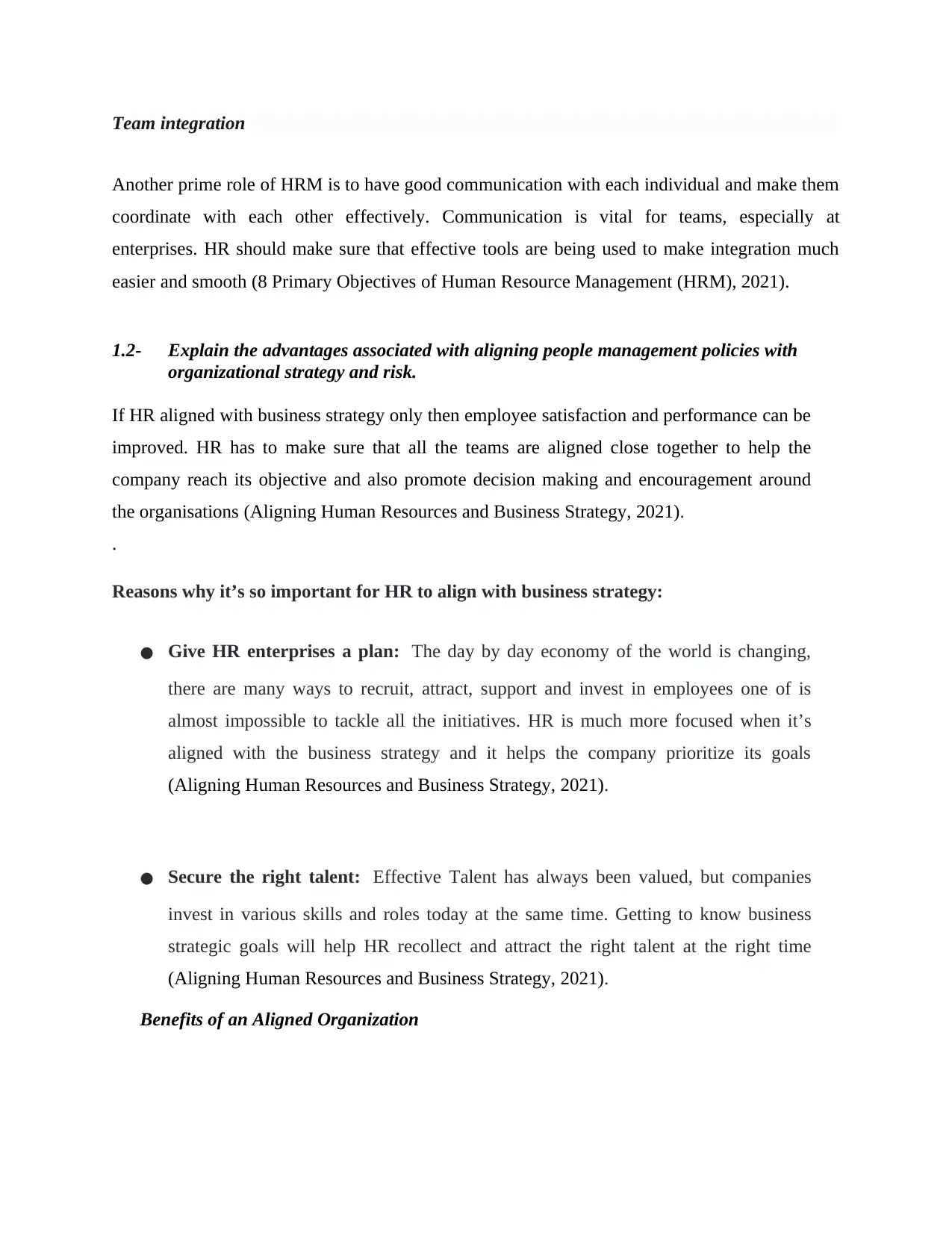
Team integration
Another prime role of HRM is to have good communication with each individual and make them
coordinate with each other effectively. Communication is vital for teams, especially at
enterprises. HR should make sure that effective tools are being used to make integration much
easier and smooth (8 Primary Objectives of Human Resource Management (HRM), 2021).
1.2- Explain the advantages associated with aligning people management policies with
organizational strategy and risk.
If HR aligned with business strategy only then employee satisfaction and performance can be
improved. HR has to make sure that all the teams are aligned close together to help the
company reach its objective and also promote decision making and encouragement around
the organisations (Aligning Human Resources and Business Strategy, 2021).
.
Reasons why it’s so important for HR to align with business strategy:
● Give HR enterprises a plan: The day by day economy of the world is changing,
there are many ways to recruit, attract, support and invest in employees one of is
almost impossible to tackle all the initiatives. HR is much more focused when it’s
aligned with the business strategy and it helps the company prioritize its goals
(Aligning Human Resources and Business Strategy, 2021).
● Secure the right talent: Effective Talent has always been valued, but companies
invest in various skills and roles today at the same time. Getting to know business
strategic goals will help HR recollect and attract the right talent at the right time
(Aligning Human Resources and Business Strategy, 2021).
Benefits of an Aligned Organization
Another prime role of HRM is to have good communication with each individual and make them
coordinate with each other effectively. Communication is vital for teams, especially at
enterprises. HR should make sure that effective tools are being used to make integration much
easier and smooth (8 Primary Objectives of Human Resource Management (HRM), 2021).
1.2- Explain the advantages associated with aligning people management policies with
organizational strategy and risk.
If HR aligned with business strategy only then employee satisfaction and performance can be
improved. HR has to make sure that all the teams are aligned close together to help the
company reach its objective and also promote decision making and encouragement around
the organisations (Aligning Human Resources and Business Strategy, 2021).
.
Reasons why it’s so important for HR to align with business strategy:
● Give HR enterprises a plan: The day by day economy of the world is changing,
there are many ways to recruit, attract, support and invest in employees one of is
almost impossible to tackle all the initiatives. HR is much more focused when it’s
aligned with the business strategy and it helps the company prioritize its goals
(Aligning Human Resources and Business Strategy, 2021).
● Secure the right talent: Effective Talent has always been valued, but companies
invest in various skills and roles today at the same time. Getting to know business
strategic goals will help HR recollect and attract the right talent at the right time
(Aligning Human Resources and Business Strategy, 2021).
Benefits of an Aligned Organization
⊘ This is a preview!⊘
Do you want full access?
Subscribe today to unlock all pages.

Trusted by 1+ million students worldwide
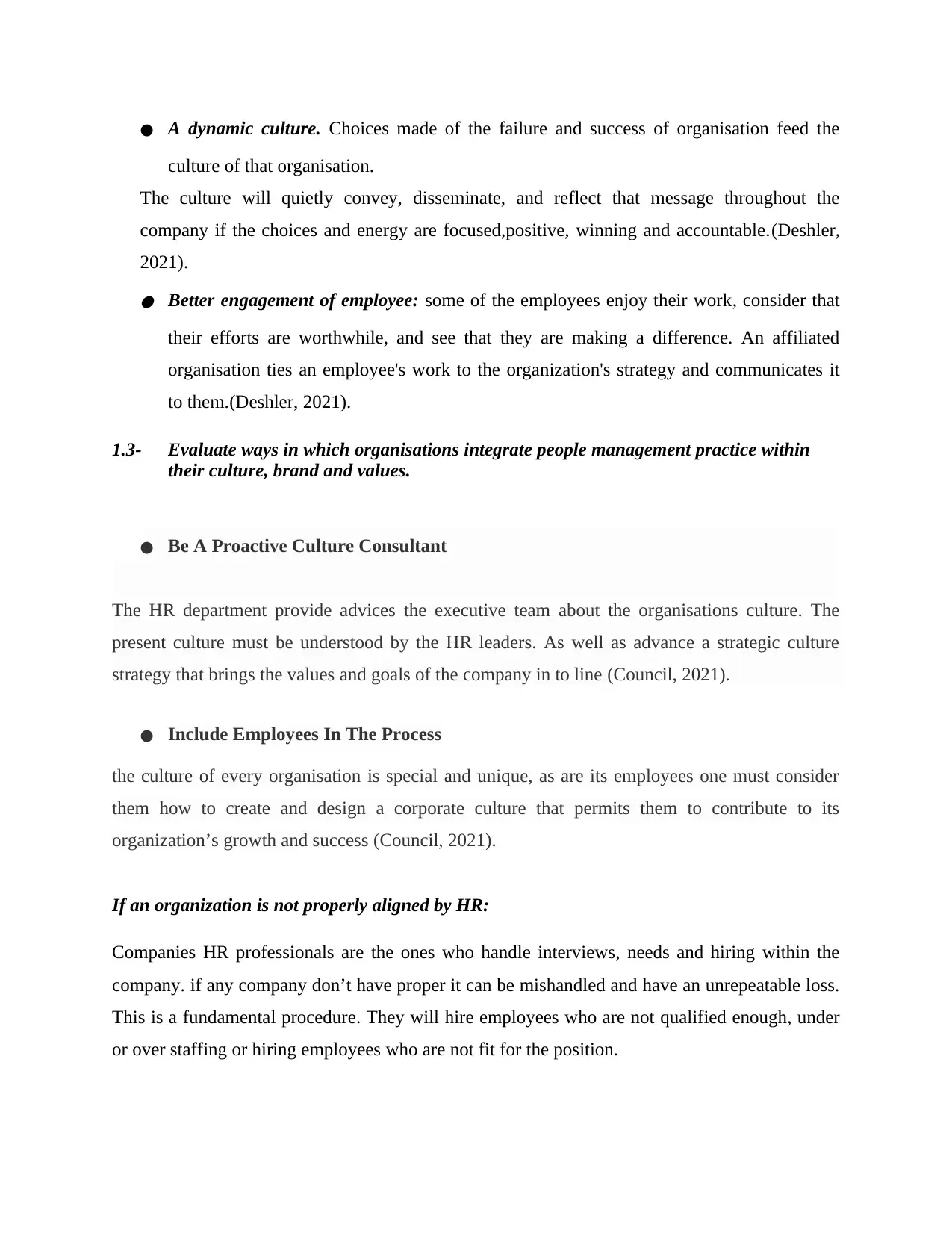
● A dynamic culture. Choices made of the failure and success of organisation feed the
culture of that organisation.
The culture will quietly convey, disseminate, and reflect that message throughout the
company if the choices and energy are focused,positive, winning and accountable.(Deshler,
2021).● Better engagement of employee: some of the employees enjoy their work, consider that
their efforts are worthwhile, and see that they are making a difference. An affiliated
organisation ties an employee's work to the organization's strategy and communicates it
to them.(Deshler, 2021).
1.3- Evaluate ways in which organisations integrate people management practice within
their culture, brand and values.
● Be A Proactive Culture Consultant
The HR department provide advices the executive team about the organisations culture. The
present culture must be understood by the HR leaders. As well as advance a strategic culture
strategy that brings the values and goals of the company in to line (Council, 2021).
● Include Employees In The Process
the culture of every organisation is special and unique, as are its employees one must consider
them how to create and design a corporate culture that permits them to contribute to its
organization’s growth and success (Council, 2021).
If an organization is not properly aligned by HR:
Companies HR professionals are the ones who handle interviews, needs and hiring within the
company. if any company don’t have proper it can be mishandled and have an unrepeatable loss.
This is a fundamental procedure. They will hire employees who are not qualified enough, under
or over staffing or hiring employees who are not fit for the position.
culture of that organisation.
The culture will quietly convey, disseminate, and reflect that message throughout the
company if the choices and energy are focused,positive, winning and accountable.(Deshler,
2021).● Better engagement of employee: some of the employees enjoy their work, consider that
their efforts are worthwhile, and see that they are making a difference. An affiliated
organisation ties an employee's work to the organization's strategy and communicates it
to them.(Deshler, 2021).
1.3- Evaluate ways in which organisations integrate people management practice within
their culture, brand and values.
● Be A Proactive Culture Consultant
The HR department provide advices the executive team about the organisations culture. The
present culture must be understood by the HR leaders. As well as advance a strategic culture
strategy that brings the values and goals of the company in to line (Council, 2021).
● Include Employees In The Process
the culture of every organisation is special and unique, as are its employees one must consider
them how to create and design a corporate culture that permits them to contribute to its
organization’s growth and success (Council, 2021).
If an organization is not properly aligned by HR:
Companies HR professionals are the ones who handle interviews, needs and hiring within the
company. if any company don’t have proper it can be mishandled and have an unrepeatable loss.
This is a fundamental procedure. They will hire employees who are not qualified enough, under
or over staffing or hiring employees who are not fit for the position.
Paraphrase This Document
Need a fresh take? Get an instant paraphrase of this document with our AI Paraphraser
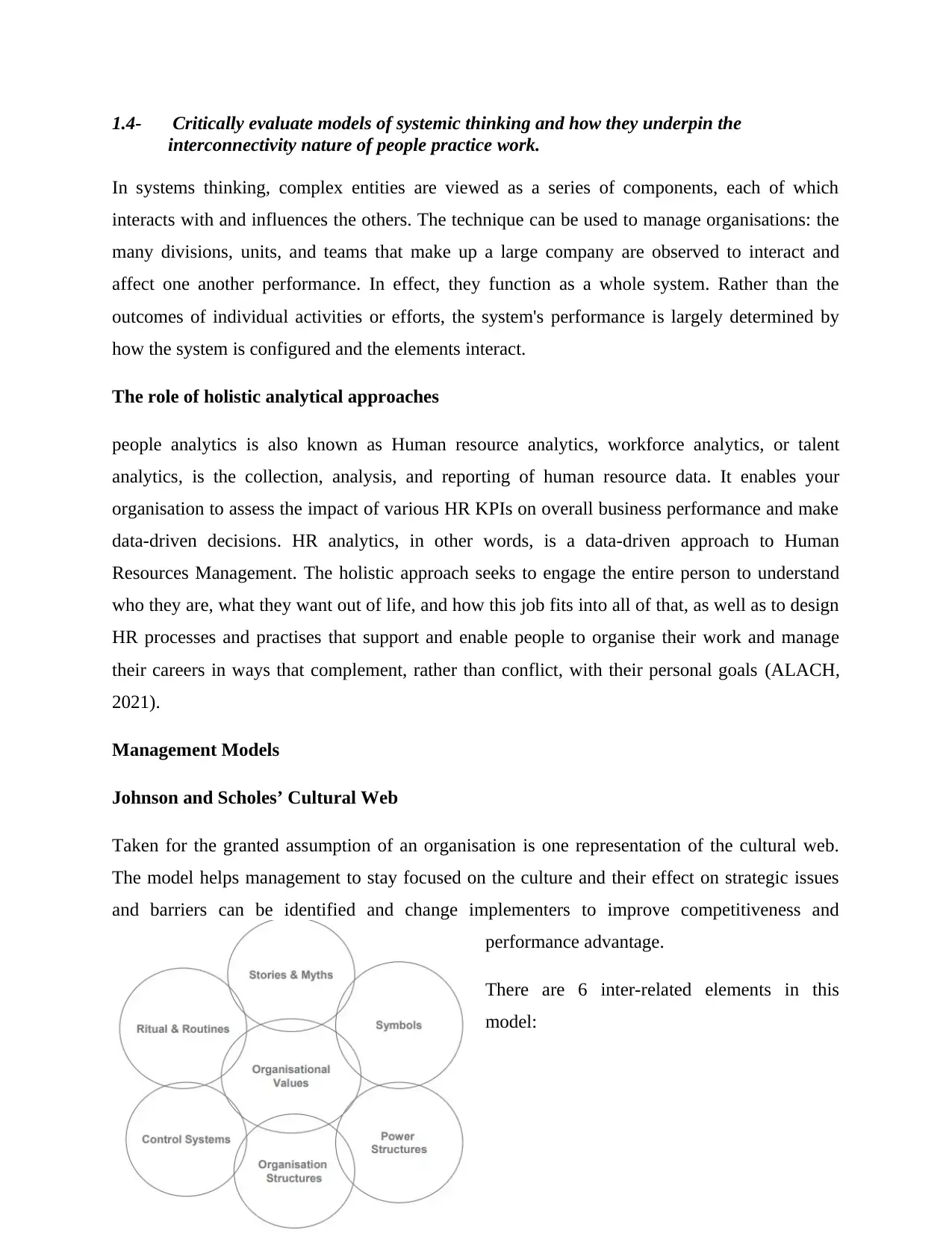
1.4- Critically evaluate models of systemic thinking and how they underpin the
interconnectivity nature of people practice work.
In systems thinking, complex entities are viewed as a series of components, each of which
interacts with and influences the others. The technique can be used to manage organisations: the
many divisions, units, and teams that make up a large company are observed to interact and
affect one another performance. In effect, they function as a whole system. Rather than the
outcomes of individual activities or efforts, the system's performance is largely determined by
how the system is configured and the elements interact.
The role of holistic analytical approaches
people analytics is also known as Human resource analytics, workforce analytics, or talent
analytics, is the collection, analysis, and reporting of human resource data. It enables your
organisation to assess the impact of various HR KPIs on overall business performance and make
data-driven decisions. HR analytics, in other words, is a data-driven approach to Human
Resources Management. The holistic approach seeks to engage the entire person to understand
who they are, what they want out of life, and how this job fits into all of that, as well as to design
HR processes and practises that support and enable people to organise their work and manage
their careers in ways that complement, rather than conflict, with their personal goals (ALACH,
2021).
Management Models
Johnson and Scholes’ Cultural Web
Taken for the granted assumption of an organisation is one representation of the cultural web.
The model helps management to stay focused on the culture and their effect on strategic issues
and barriers can be identified and change implementers to improve competitiveness and
performance advantage.
There are 6 inter-related elements in this
model:
interconnectivity nature of people practice work.
In systems thinking, complex entities are viewed as a series of components, each of which
interacts with and influences the others. The technique can be used to manage organisations: the
many divisions, units, and teams that make up a large company are observed to interact and
affect one another performance. In effect, they function as a whole system. Rather than the
outcomes of individual activities or efforts, the system's performance is largely determined by
how the system is configured and the elements interact.
The role of holistic analytical approaches
people analytics is also known as Human resource analytics, workforce analytics, or talent
analytics, is the collection, analysis, and reporting of human resource data. It enables your
organisation to assess the impact of various HR KPIs on overall business performance and make
data-driven decisions. HR analytics, in other words, is a data-driven approach to Human
Resources Management. The holistic approach seeks to engage the entire person to understand
who they are, what they want out of life, and how this job fits into all of that, as well as to design
HR processes and practises that support and enable people to organise their work and manage
their careers in ways that complement, rather than conflict, with their personal goals (ALACH,
2021).
Management Models
Johnson and Scholes’ Cultural Web
Taken for the granted assumption of an organisation is one representation of the cultural web.
The model helps management to stay focused on the culture and their effect on strategic issues
and barriers can be identified and change implementers to improve competitiveness and
performance advantage.
There are 6 inter-related elements in this
model:
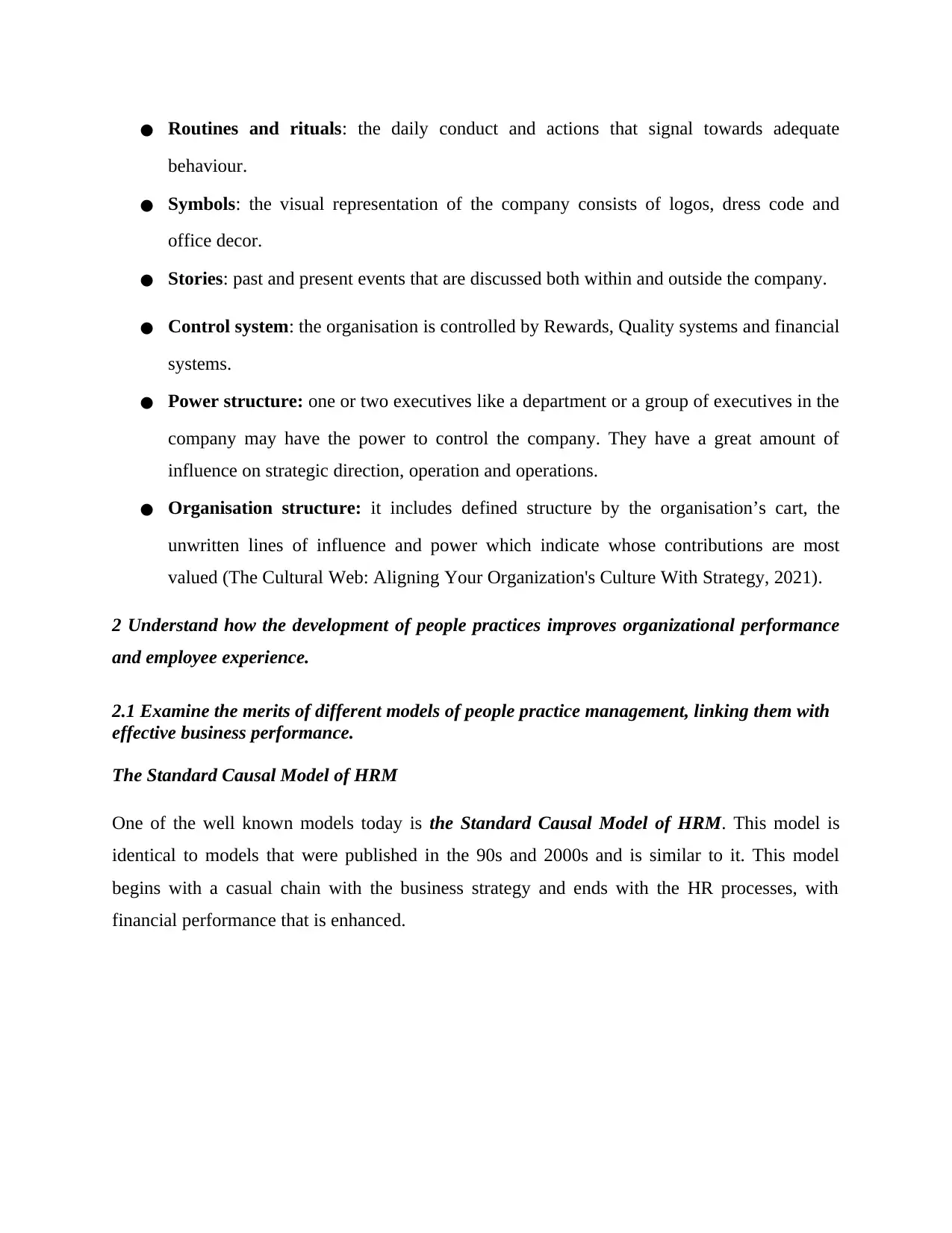
● Routines and rituals: the daily conduct and actions that signal towards adequate
behaviour.
● Symbols: the visual representation of the company consists of logos, dress code and
office decor.
● Stories: past and present events that are discussed both within and outside the company.
● Control system: the organisation is controlled by Rewards, Quality systems and financial
systems.
● Power structure: one or two executives like a department or a group of executives in the
company may have the power to control the company. They have a great amount of
influence on strategic direction, operation and operations.
● Organisation structure: it includes defined structure by the organisation’s cart, the
unwritten lines of influence and power which indicate whose contributions are most
valued (The Cultural Web: Aligning Your Organization's Culture With Strategy, 2021).
2 Understand how the development of people practices improves organizational performance
and employee experience.
2.1 Examine the merits of different models of people practice management, linking them with
effective business performance.
The Standard Causal Model of HRM
One of the well known models today is the Standard Causal Model of HRM. This model is
identical to models that were published in the 90s and 2000s and is similar to it. This model
begins with a casual chain with the business strategy and ends with the HR processes, with
financial performance that is enhanced.
behaviour.
● Symbols: the visual representation of the company consists of logos, dress code and
office decor.
● Stories: past and present events that are discussed both within and outside the company.
● Control system: the organisation is controlled by Rewards, Quality systems and financial
systems.
● Power structure: one or two executives like a department or a group of executives in the
company may have the power to control the company. They have a great amount of
influence on strategic direction, operation and operations.
● Organisation structure: it includes defined structure by the organisation’s cart, the
unwritten lines of influence and power which indicate whose contributions are most
valued (The Cultural Web: Aligning Your Organization's Culture With Strategy, 2021).
2 Understand how the development of people practices improves organizational performance
and employee experience.
2.1 Examine the merits of different models of people practice management, linking them with
effective business performance.
The Standard Causal Model of HRM
One of the well known models today is the Standard Causal Model of HRM. This model is
identical to models that were published in the 90s and 2000s and is similar to it. This model
begins with a casual chain with the business strategy and ends with the HR processes, with
financial performance that is enhanced.
⊘ This is a preview!⊘
Do you want full access?
Subscribe today to unlock all pages.

Trusted by 1+ million students worldwide
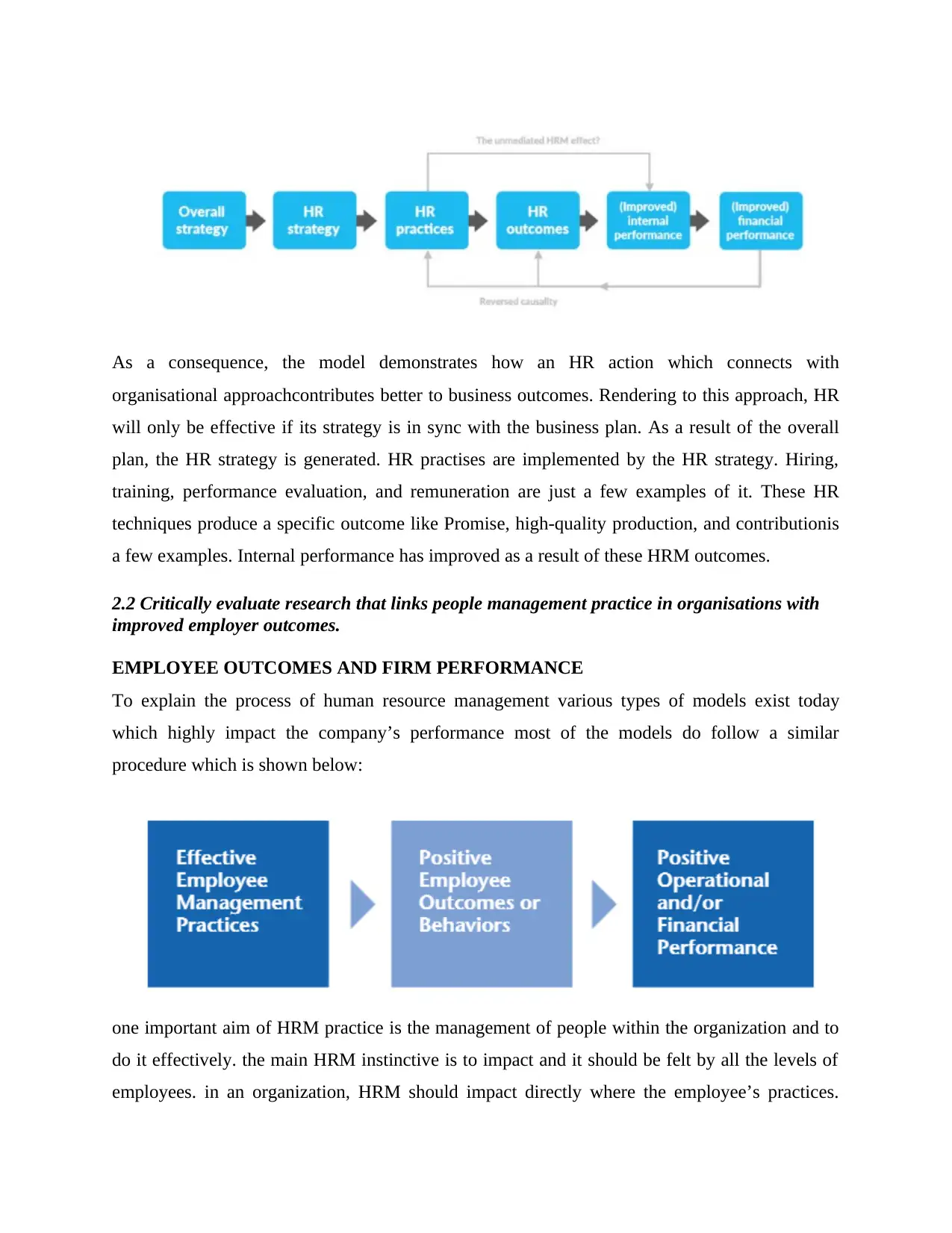
As a consequence, the model demonstrates how an HR action which connects with
organisational approachcontributes better to business outcomes. Rendering to this approach, HR
will only be effective if its strategy is in sync with the business plan. As a result of the overall
plan, the HR strategy is generated. HR practises are implemented by the HR strategy. Hiring,
training, performance evaluation, and remuneration are just a few examples of it. These HR
techniques produce a specific outcome like Promise, high-quality production, and contributionis
a few examples. Internal performance has improved as a result of these HRM outcomes.
2.2 Critically evaluate research that links people management practice in organisations with
improved employer outcomes.
EMPLOYEE OUTCOMES AND FIRM PERFORMANCE
To explain the process of human resource management various types of models exist today
which highly impact the company’s performance most of the models do follow a similar
procedure which is shown below:
one important aim of HRM practice is the management of people within the organization and to
do it effectively. the main HRM instinctive is to impact and it should be felt by all the levels of
employees. in an organization, HRM should impact directly where the employee’s practices.
organisational approachcontributes better to business outcomes. Rendering to this approach, HR
will only be effective if its strategy is in sync with the business plan. As a result of the overall
plan, the HR strategy is generated. HR practises are implemented by the HR strategy. Hiring,
training, performance evaluation, and remuneration are just a few examples of it. These HR
techniques produce a specific outcome like Promise, high-quality production, and contributionis
a few examples. Internal performance has improved as a result of these HRM outcomes.
2.2 Critically evaluate research that links people management practice in organisations with
improved employer outcomes.
EMPLOYEE OUTCOMES AND FIRM PERFORMANCE
To explain the process of human resource management various types of models exist today
which highly impact the company’s performance most of the models do follow a similar
procedure which is shown below:
one important aim of HRM practice is the management of people within the organization and to
do it effectively. the main HRM instinctive is to impact and it should be felt by all the levels of
employees. in an organization, HRM should impact directly where the employee’s practices.
Paraphrase This Document
Need a fresh take? Get an instant paraphrase of this document with our AI Paraphraser
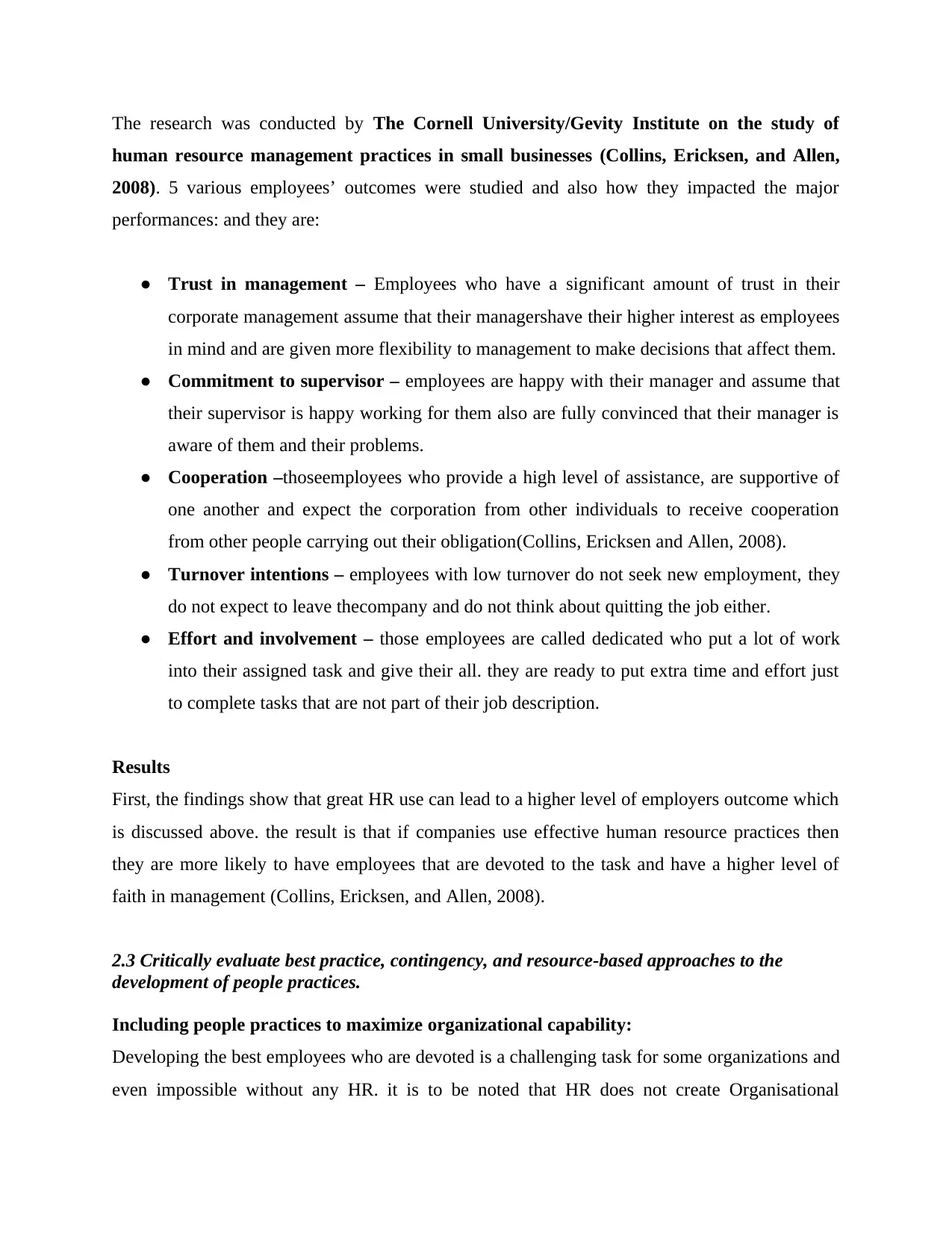
The research was conducted by The Cornell University/Gevity Institute on the study of
human resource management practices in small businesses (Collins, Ericksen, and Allen,
2008). 5 various employees’ outcomes were studied and also how they impacted the major
performances: and they are:
● Trust in management – Employees who have a significant amount of trust in their
corporate management assume that their managershave their higher interest as employees
in mind and are given more flexibility to management to make decisions that affect them.
● Commitment to supervisor – employees are happy with their manager and assume that
their supervisor is happy working for them also are fully convinced that their manager is
aware of them and their problems.
● Cooperation –thoseemployees who provide a high level of assistance, are supportive of
one another and expect the corporation from other individuals to receive cooperation
from other people carrying out their obligation(Collins, Ericksen and Allen, 2008).
● Turnover intentions – employees with low turnover do not seek new employment, they
do not expect to leave thecompany and do not think about quitting the job either.
● Effort and involvement – those employees are called dedicated who put a lot of work
into their assigned task and give their all. they are ready to put extra time and effort just
to complete tasks that are not part of their job description.
Results
First, the findings show that great HR use can lead to a higher level of employers outcome which
is discussed above. the result is that if companies use effective human resource practices then
they are more likely to have employees that are devoted to the task and have a higher level of
faith in management (Collins, Ericksen, and Allen, 2008).
2.3 Critically evaluate best practice, contingency, and resource-based approaches to the
development of people practices.
Including people practices to maximize organizational capability:
Developing the best employees who are devoted is a challenging task for some organizations and
even impossible without any HR. it is to be noted that HR does not create Organisational
human resource management practices in small businesses (Collins, Ericksen, and Allen,
2008). 5 various employees’ outcomes were studied and also how they impacted the major
performances: and they are:
● Trust in management – Employees who have a significant amount of trust in their
corporate management assume that their managershave their higher interest as employees
in mind and are given more flexibility to management to make decisions that affect them.
● Commitment to supervisor – employees are happy with their manager and assume that
their supervisor is happy working for them also are fully convinced that their manager is
aware of them and their problems.
● Cooperation –thoseemployees who provide a high level of assistance, are supportive of
one another and expect the corporation from other individuals to receive cooperation
from other people carrying out their obligation(Collins, Ericksen and Allen, 2008).
● Turnover intentions – employees with low turnover do not seek new employment, they
do not expect to leave thecompany and do not think about quitting the job either.
● Effort and involvement – those employees are called dedicated who put a lot of work
into their assigned task and give their all. they are ready to put extra time and effort just
to complete tasks that are not part of their job description.
Results
First, the findings show that great HR use can lead to a higher level of employers outcome which
is discussed above. the result is that if companies use effective human resource practices then
they are more likely to have employees that are devoted to the task and have a higher level of
faith in management (Collins, Ericksen, and Allen, 2008).
2.3 Critically evaluate best practice, contingency, and resource-based approaches to the
development of people practices.
Including people practices to maximize organizational capability:
Developing the best employees who are devoted is a challenging task for some organizations and
even impossible without any HR. it is to be noted that HR does not create Organisational
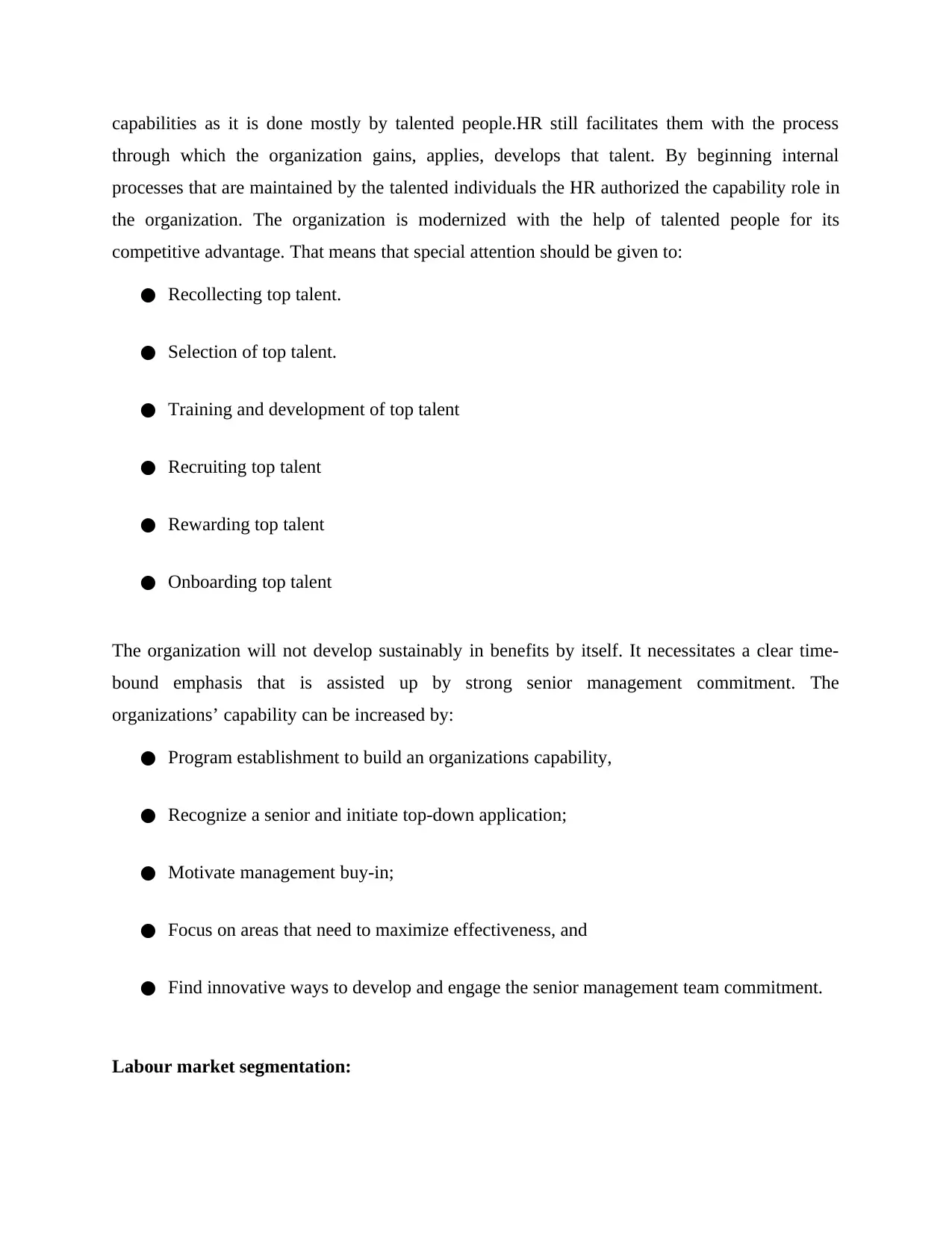
capabilities as it is done mostly by talented people.HR still facilitates them with the process
through which the organization gains, applies, develops that talent. By beginning internal
processes that are maintained by the talented individuals the HR authorized the capability role in
the organization. The organization is modernized with the help of talented people for its
competitive advantage. That means that special attention should be given to:
● Recollecting top talent.
● Selection of top talent.
● Training and development of top talent
● Recruiting top talent
● Rewarding top talent
● Onboarding top talent
The organization will not develop sustainably in benefits by itself. It necessitates a clear time-
bound emphasis that is assisted up by strong senior management commitment. The
organizations’ capability can be increased by:
● Program establishment to build an organizations capability,
● Recognize a senior and initiate top-down application;
● Motivate management buy-in;
● Focus on areas that need to maximize effectiveness, and
● Find innovative ways to develop and engage the senior management team commitment.
Labour market segmentation:
through which the organization gains, applies, develops that talent. By beginning internal
processes that are maintained by the talented individuals the HR authorized the capability role in
the organization. The organization is modernized with the help of talented people for its
competitive advantage. That means that special attention should be given to:
● Recollecting top talent.
● Selection of top talent.
● Training and development of top talent
● Recruiting top talent
● Rewarding top talent
● Onboarding top talent
The organization will not develop sustainably in benefits by itself. It necessitates a clear time-
bound emphasis that is assisted up by strong senior management commitment. The
organizations’ capability can be increased by:
● Program establishment to build an organizations capability,
● Recognize a senior and initiate top-down application;
● Motivate management buy-in;
● Focus on areas that need to maximize effectiveness, and
● Find innovative ways to develop and engage the senior management team commitment.
Labour market segmentation:
⊘ This is a preview!⊘
Do you want full access?
Subscribe today to unlock all pages.

Trusted by 1+ million students worldwide
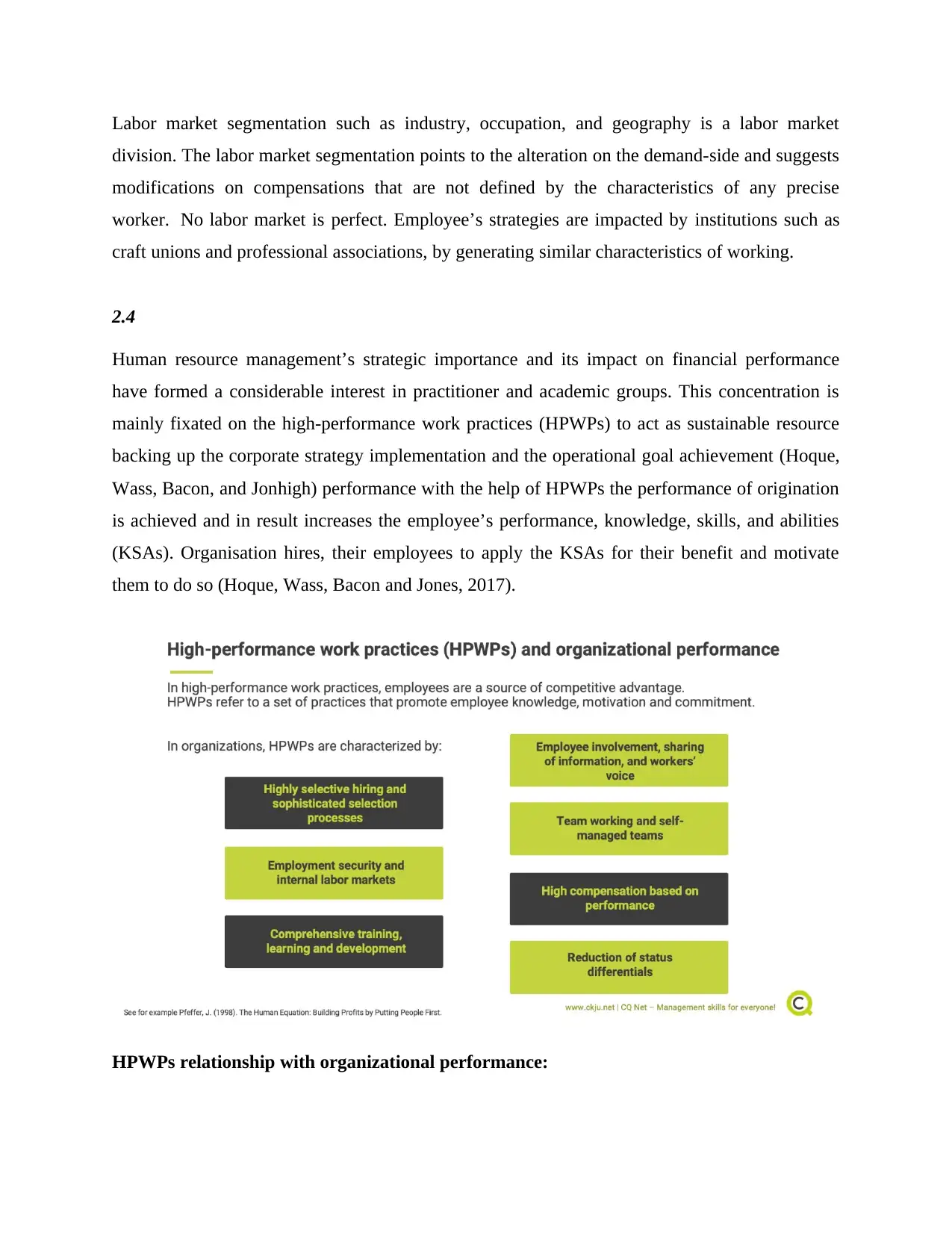
Labor market segmentation such as industry, occupation, and geography is a labor market
division. The labor market segmentation points to the alteration on the demand-side and suggests
modifications on compensations that are not defined by the characteristics of any precise
worker. No labor market is perfect. Employee’s strategies are impacted by institutions such as
craft unions and professional associations, by generating similar characteristics of working.
2.4
Human resource management’s strategic importance and its impact on financial performance
have formed a considerable interest in practitioner and academic groups. This concentration is
mainly fixated on the high-performance work practices (HPWPs) to act as sustainable resource
backing up the corporate strategy implementation and the operational goal achievement (Hoque,
Wass, Bacon, and Jonhigh) performance with the help of HPWPs the performance of origination
is achieved and in result increases the employee’s performance, knowledge, skills, and abilities
(KSAs). Organisation hires, their employees to apply the KSAs for their benefit and motivate
them to do so (Hoque, Wass, Bacon and Jones, 2017).
HPWPs relationship with organizational performance:
division. The labor market segmentation points to the alteration on the demand-side and suggests
modifications on compensations that are not defined by the characteristics of any precise
worker. No labor market is perfect. Employee’s strategies are impacted by institutions such as
craft unions and professional associations, by generating similar characteristics of working.
2.4
Human resource management’s strategic importance and its impact on financial performance
have formed a considerable interest in practitioner and academic groups. This concentration is
mainly fixated on the high-performance work practices (HPWPs) to act as sustainable resource
backing up the corporate strategy implementation and the operational goal achievement (Hoque,
Wass, Bacon, and Jonhigh) performance with the help of HPWPs the performance of origination
is achieved and in result increases the employee’s performance, knowledge, skills, and abilities
(KSAs). Organisation hires, their employees to apply the KSAs for their benefit and motivate
them to do so (Hoque, Wass, Bacon and Jones, 2017).
HPWPs relationship with organizational performance:
Paraphrase This Document
Need a fresh take? Get an instant paraphrase of this document with our AI Paraphraser
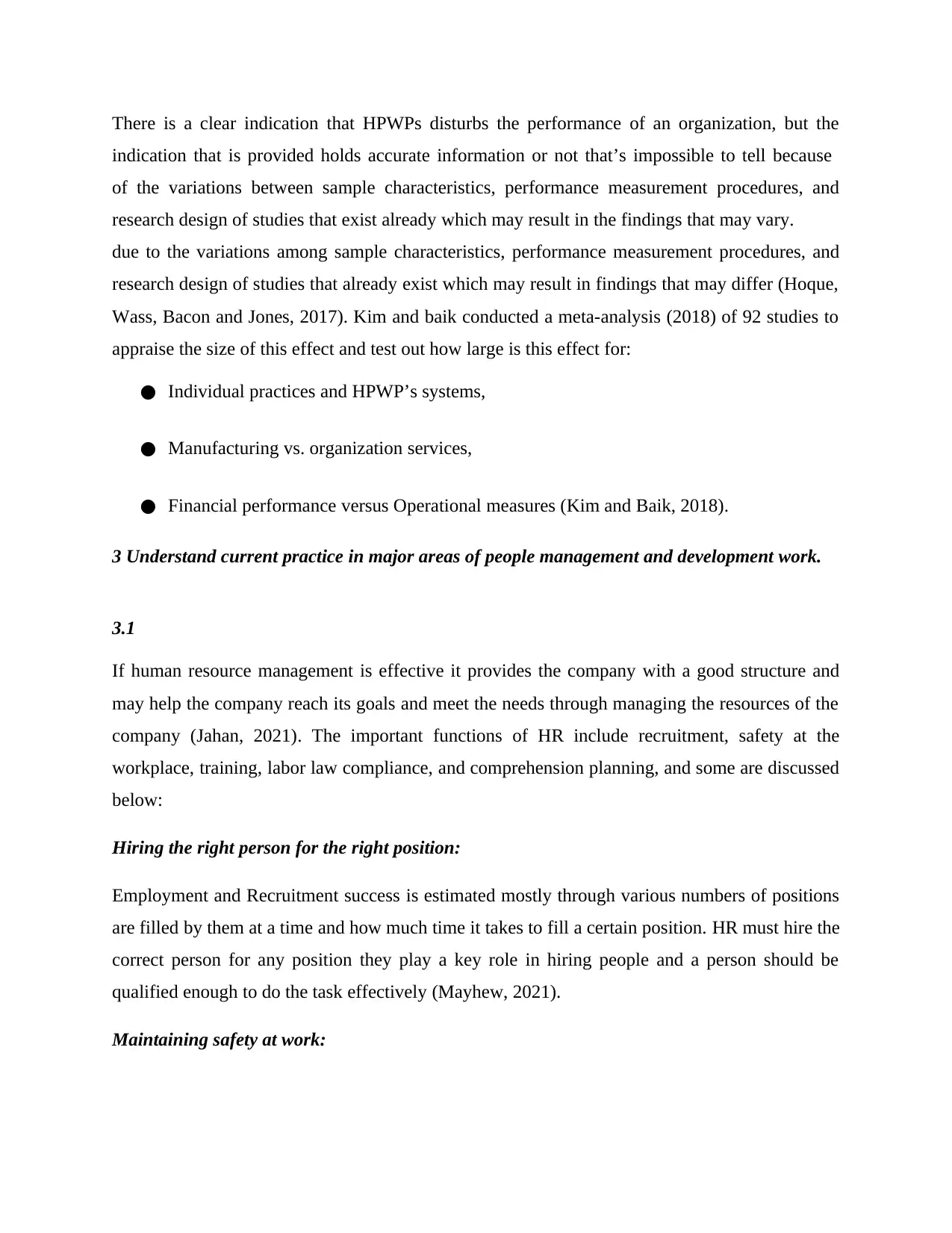
There is a clear indication that HPWPs disturbs the performance of an organization, but the
indication that is provided holds accurate information or not that’s impossible to tell because
of the variations between sample characteristics, performance measurement procedures, and
research design of studies that exist already which may result in the findings that may vary.
due to the variations among sample characteristics, performance measurement procedures, and
research design of studies that already exist which may result in findings that may differ (Hoque,
Wass, Bacon and Jones, 2017). Kim and baik conducted a meta-analysis (2018) of 92 studies to
appraise the size of this effect and test out how large is this effect for:
● Individual practices and HPWP’s systems,
● Manufacturing vs. organization services,
● Financial performance versus Operational measures (Kim and Baik, 2018).
3 Understand current practice in major areas of people management and development work.
3.1
If human resource management is effective it provides the company with a good structure and
may help the company reach its goals and meet the needs through managing the resources of the
company (Jahan, 2021). The important functions of HR include recruitment, safety at the
workplace, training, labor law compliance, and comprehension planning, and some are discussed
below:
Hiring the right person for the right position:
Employment and Recruitment success is estimated mostly through various numbers of positions
are filled by them at a time and how much time it takes to fill a certain position. HR must hire the
correct person for any position they play a key role in hiring people and a person should be
qualified enough to do the task effectively (Mayhew, 2021).
Maintaining safety at work:
indication that is provided holds accurate information or not that’s impossible to tell because
of the variations between sample characteristics, performance measurement procedures, and
research design of studies that exist already which may result in the findings that may vary.
due to the variations among sample characteristics, performance measurement procedures, and
research design of studies that already exist which may result in findings that may differ (Hoque,
Wass, Bacon and Jones, 2017). Kim and baik conducted a meta-analysis (2018) of 92 studies to
appraise the size of this effect and test out how large is this effect for:
● Individual practices and HPWP’s systems,
● Manufacturing vs. organization services,
● Financial performance versus Operational measures (Kim and Baik, 2018).
3 Understand current practice in major areas of people management and development work.
3.1
If human resource management is effective it provides the company with a good structure and
may help the company reach its goals and meet the needs through managing the resources of the
company (Jahan, 2021). The important functions of HR include recruitment, safety at the
workplace, training, labor law compliance, and comprehension planning, and some are discussed
below:
Hiring the right person for the right position:
Employment and Recruitment success is estimated mostly through various numbers of positions
are filled by them at a time and how much time it takes to fill a certain position. HR must hire the
correct person for any position they play a key role in hiring people and a person should be
qualified enough to do the task effectively (Mayhew, 2021).
Maintaining safety at work:
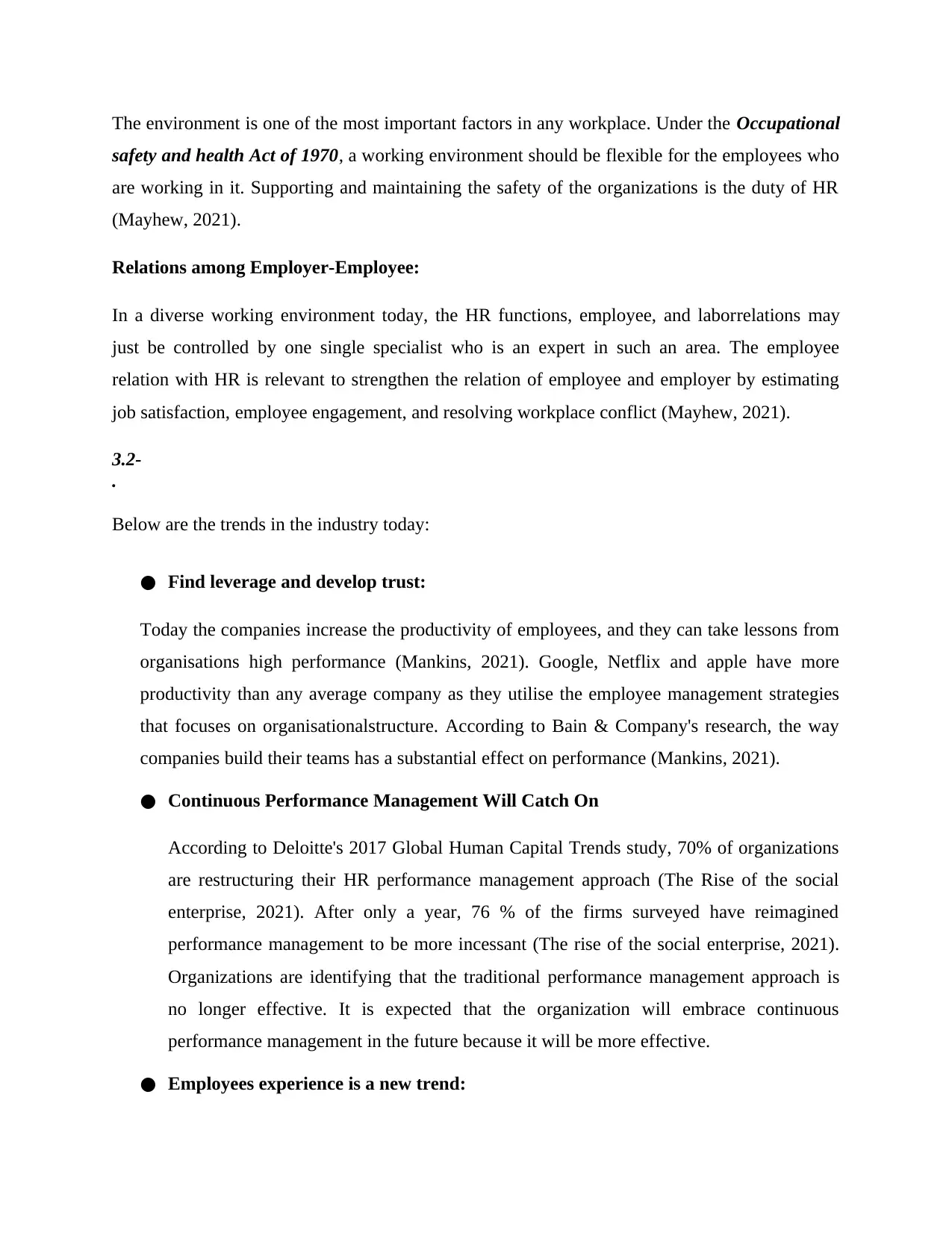
The environment is one of the most important factors in any workplace. Under the Occupational
safety and health Act of 1970, a working environment should be flexible for the employees who
are working in it. Supporting and maintaining the safety of the organizations is the duty of HR
(Mayhew, 2021).
Relations among Employer-Employee:
In a diverse working environment today, the HR functions, employee, and laborrelations may
just be controlled by one single specialist who is an expert in such an area. The employee
relation with HR is relevant to strengthen the relation of employee and employer by estimating
job satisfaction, employee engagement, and resolving workplace conflict (Mayhew, 2021).
3.2-
.
Below are the trends in the industry today:
● Find leverage and develop trust:
Today the companies increase the productivity of employees, and they can take lessons from
organisations high performance (Mankins, 2021). Google, Netflix and apple have more
productivity than any average company as they utilise the employee management strategies
that focuses on organisationalstructure. According to Bain & Company's research, the way
companies build their teams has a substantial effect on performance (Mankins, 2021).
● Continuous Performance Management Will Catch On
According to Deloitte's 2017 Global Human Capital Trends study, 70% of organizations
are restructuring their HR performance management approach (The Rise of the social
enterprise, 2021). After only a year, 76 % of the firms surveyed have reimagined
performance management to be more incessant (The rise of the social enterprise, 2021).
Organizations are identifying that the traditional performance management approach is
no longer effective. It is expected that the organization will embrace continuous
performance management in the future because it will be more effective.
● Employees experience is a new trend:
safety and health Act of 1970, a working environment should be flexible for the employees who
are working in it. Supporting and maintaining the safety of the organizations is the duty of HR
(Mayhew, 2021).
Relations among Employer-Employee:
In a diverse working environment today, the HR functions, employee, and laborrelations may
just be controlled by one single specialist who is an expert in such an area. The employee
relation with HR is relevant to strengthen the relation of employee and employer by estimating
job satisfaction, employee engagement, and resolving workplace conflict (Mayhew, 2021).
3.2-
.
Below are the trends in the industry today:
● Find leverage and develop trust:
Today the companies increase the productivity of employees, and they can take lessons from
organisations high performance (Mankins, 2021). Google, Netflix and apple have more
productivity than any average company as they utilise the employee management strategies
that focuses on organisationalstructure. According to Bain & Company's research, the way
companies build their teams has a substantial effect on performance (Mankins, 2021).
● Continuous Performance Management Will Catch On
According to Deloitte's 2017 Global Human Capital Trends study, 70% of organizations
are restructuring their HR performance management approach (The Rise of the social
enterprise, 2021). After only a year, 76 % of the firms surveyed have reimagined
performance management to be more incessant (The rise of the social enterprise, 2021).
Organizations are identifying that the traditional performance management approach is
no longer effective. It is expected that the organization will embrace continuous
performance management in the future because it will be more effective.
● Employees experience is a new trend:
⊘ This is a preview!⊘
Do you want full access?
Subscribe today to unlock all pages.

Trusted by 1+ million students worldwide
1 out of 21
Related Documents
Your All-in-One AI-Powered Toolkit for Academic Success.
+13062052269
info@desklib.com
Available 24*7 on WhatsApp / Email
![[object Object]](/_next/static/media/star-bottom.7253800d.svg)
Unlock your academic potential
Copyright © 2020–2025 A2Z Services. All Rights Reserved. Developed and managed by ZUCOL.



